My partner’s partner: exploring poly math on Feeld
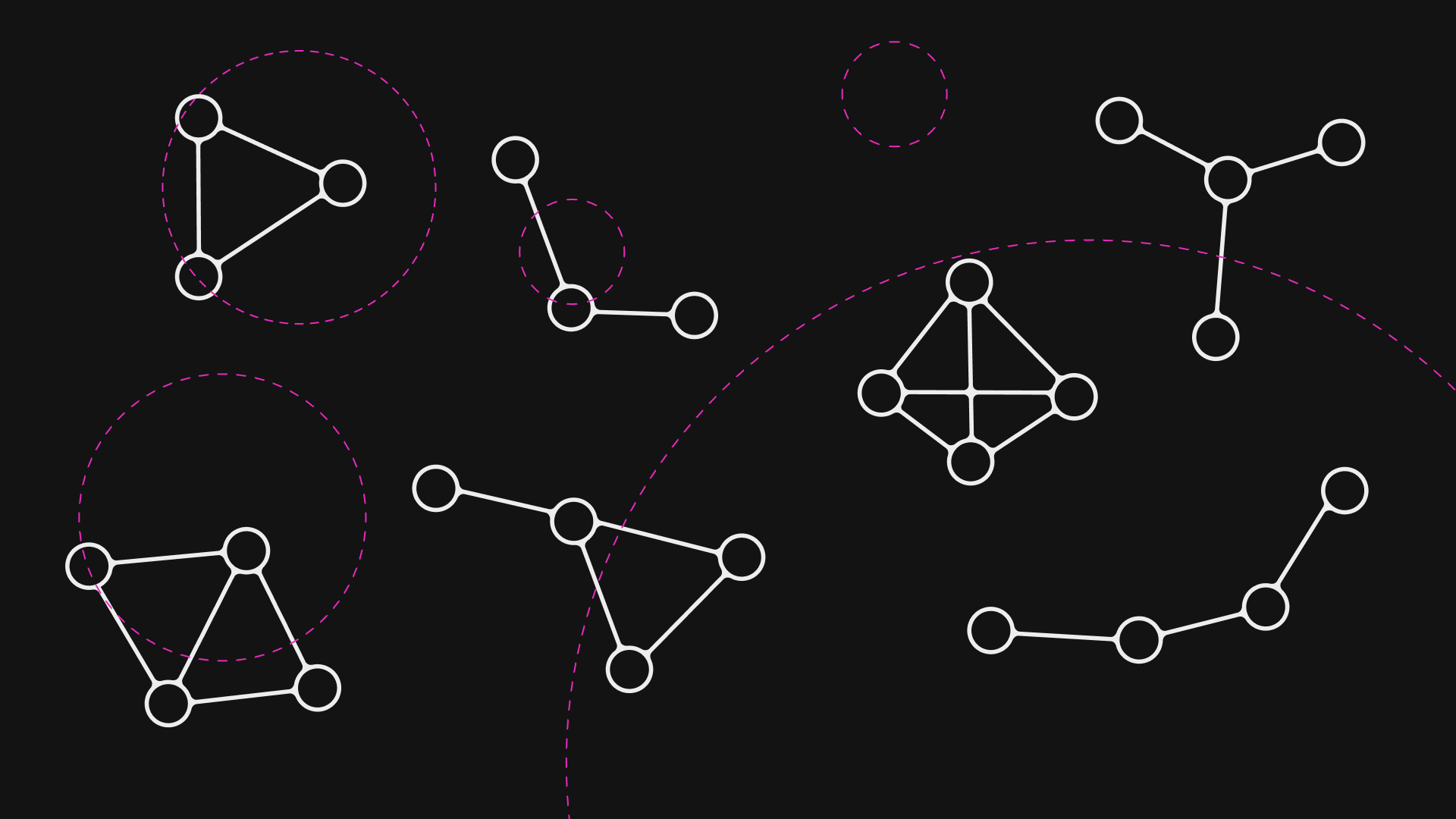
Join us as we journey into Uncharted Territory—Feeld’s data blog dedicated to celebrating the curiosities, evolutions, and experiences of our Members.
In the night sky, stars that are thousands of light years apart come together as beautiful constellations from our earthly perspective. On Feeld, community Members from different backgrounds and relationship types link their profiles together as Feeld Constellations. From an individual Member’s perspective, they may have linked their profile to one or a few others (up to 5 are currently supported), but when those paired profiles link with other paired profiles and those with even more, a whole network of Constellations comes into focus that we can only understand by taking a step back to appreciate the collection of individuals who make up the whole.
In the vocabulary of open relationships, ethical non-monogamy, and polyamory, we have a word for a partner of your partner: Metamour. But who are your second-degree metamours, and how many do you have? What about third-degree metamours? If you follow the chain of partners of partners of partners, how big is your relationship network? How many degrees of separation are you removed from those in your partner network? What are our Members’ “Kevin Bacon numbers”?
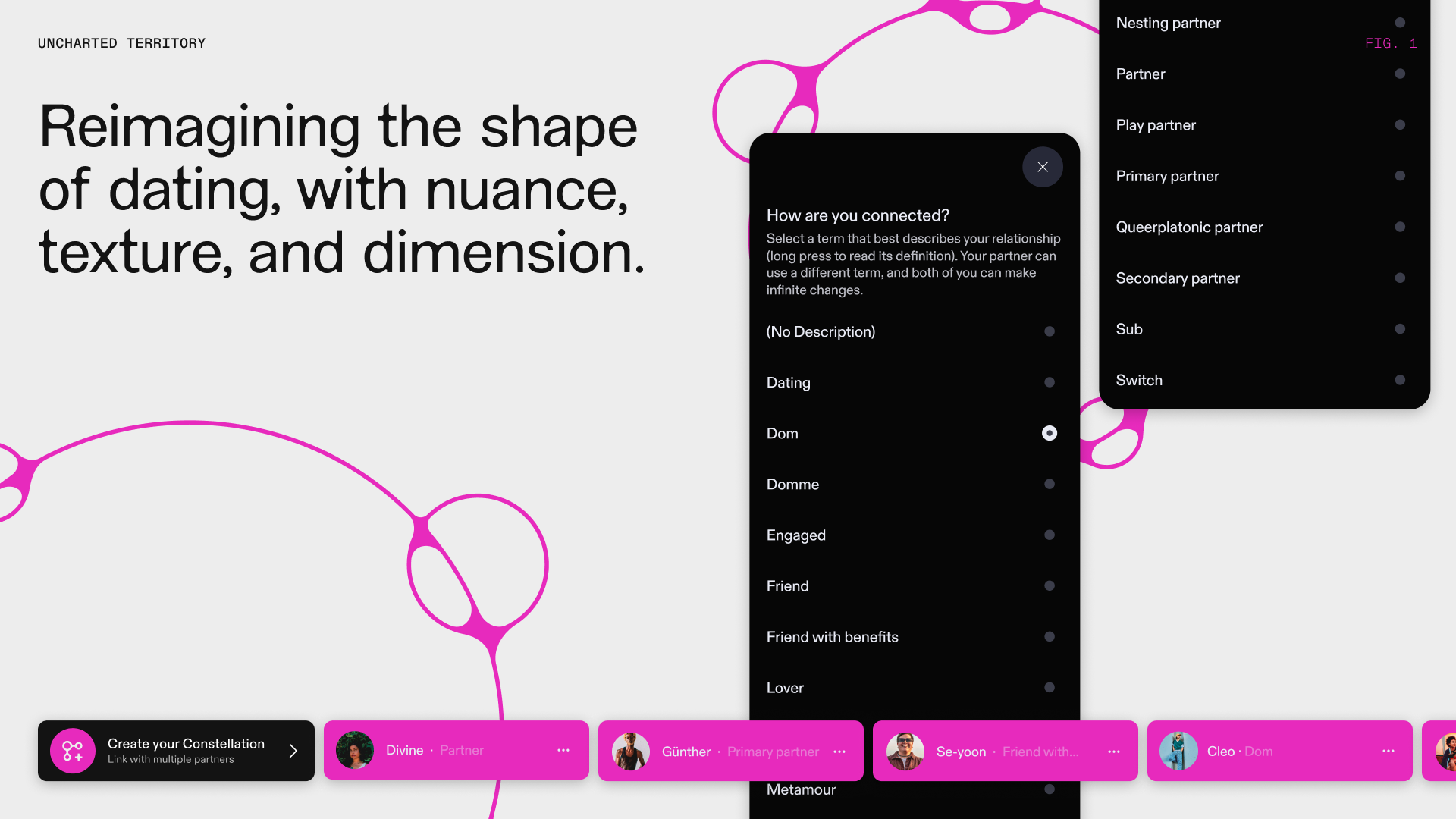
Feeld Members can add up to 5 other profiles in their Constellation with various labels from Metamour to Dom(me) to Friend.
Six months after launching this feature, we are digging into the Constellations our Members have formed to provide an unprecedented quantitative analysis of real-life non-monogamous relationship networks. What we have found so far is a beautiful galaxy of relationship structures made up of all sorts of people expressing truly diverse forms of love and connection.
Although 97% of Constellations on Feeld are couples, there are still thousands of Constellations with 3+ Members, and the number of those has doubled in the past 3 months. Triads are the most popular, followed by groups of 4, then groups of 5, and so on, up to the largest Constellation of 15 Feeld Members!
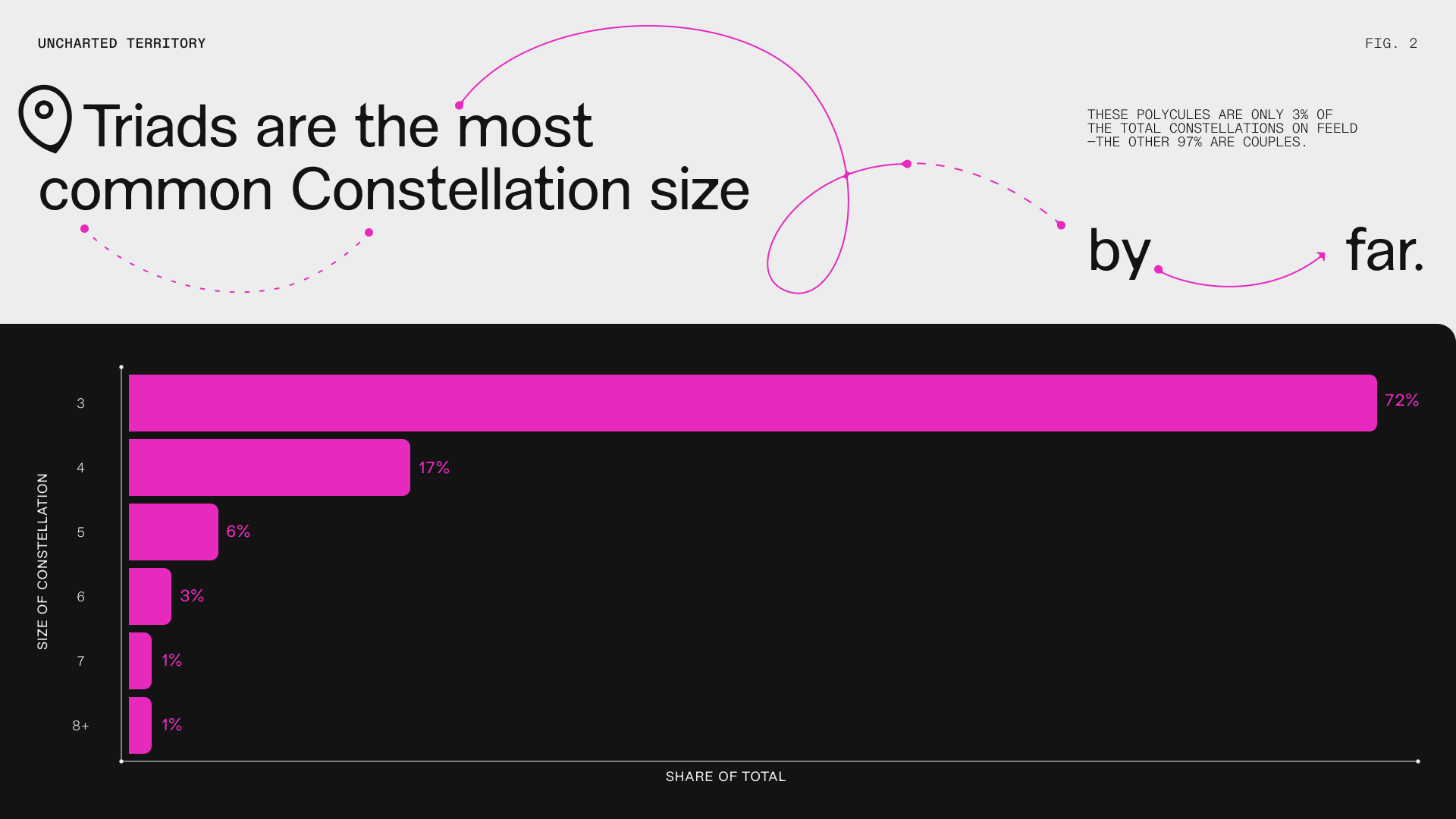
Most triads are comprised of a central “hub” Member connected to 2 “spoke” Members forming a “chain,” rather than all three Members being connected to each other. In fact, only 1 in 5 triads have every Member linked to every other Member in a “ring.” Although the popular conception of a polycule is that everyone is dating everyone, the truth on Feeld is that most Members in a triad are usually only linked with one other Member, forming more of a chain than a ring.
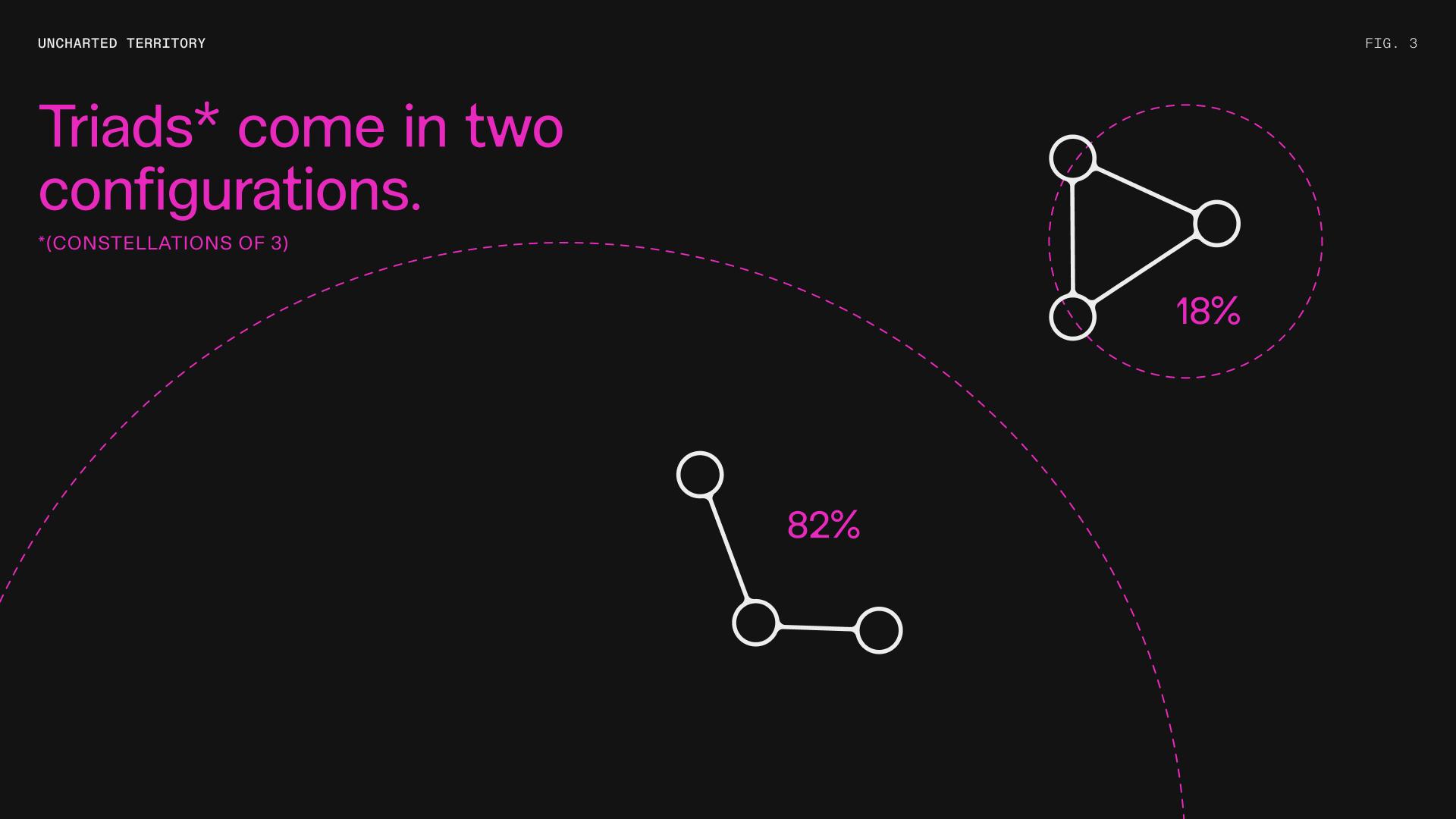
This pattern holds true for larger Constellations too. In quad-Member Constellations, over two-thirds are chain-style or hub-and-spoke style, which have the minimum number of possible links. Only 7% of quad Constellations have every Member connected to each other in a denser “ring.”
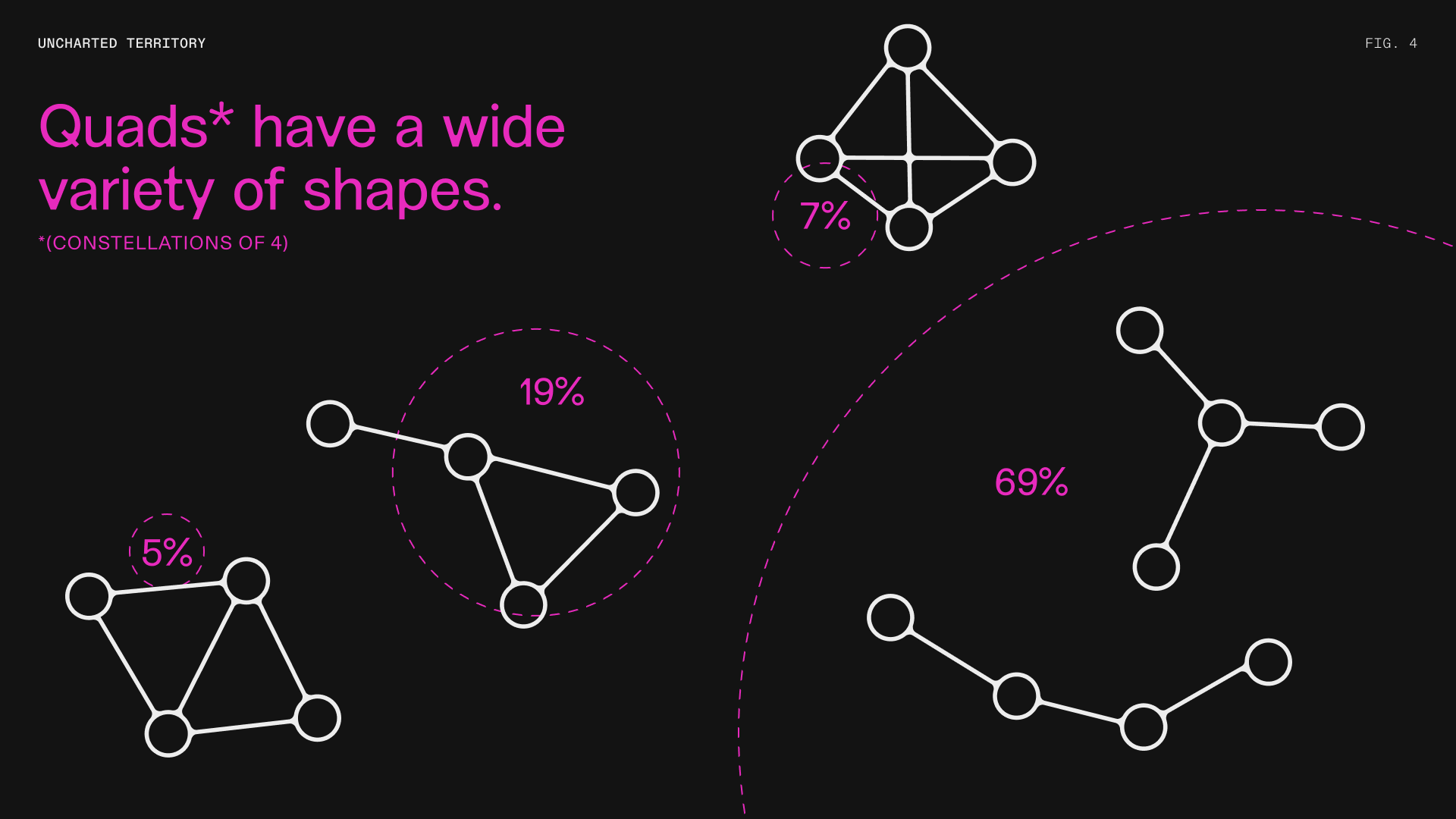
In fact, the larger the Constellation, the more chain-like and less saturated with links it is. This makes sense—in a 10+ Member Constellation it is unlikely that every single Member is linked to every single other Member. This may be the first ever quantitative indicator of “polysaturation”: the number of partners an individual can sustainably commit to. While some individual Feeld Members have 3, 4, or even 5 partners linked in their profiles, the dominance of chain-style Constellations tells us that far more people become polysaturated at just 1 or 2 partners.
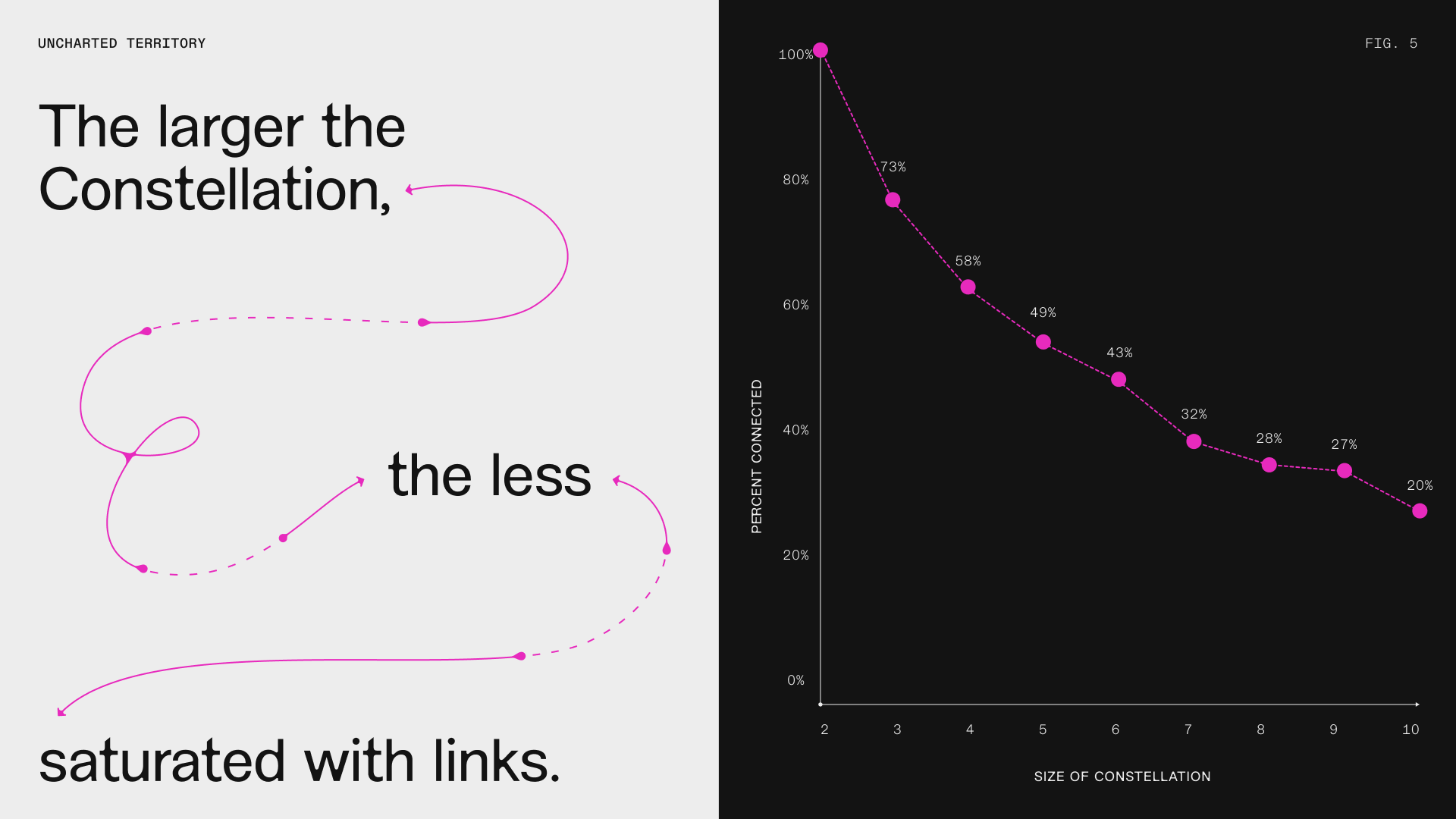
So how many partners does the average Member in a Constellation have? The answer varies greatly depending on the demographics of the Member. Bisexual, pansexual, and queer women have the most Constellation partners with an average of 2 each. This is 25% more than straight women and men, who each average 1.6. This higher average number of Constellation partners is due to to the fact that these Members in particular are 3x more likely to be hubs in their Constellations—bisexual, pansexual, and queer women are the glue of Constellations connecting different branches into the same network.
Overall, Members in Constellations skew more queer and trans than the global Feeld community. Moreover, Members of what we lovingly call the "alphabet mafia" have more Constellation partners than their cisgender and straight peers. Transgender, non-binary, and genderqueer Members have 10% more partners on average than cisgender men while pansexual, bisexual, and queer Members have 19% more partners than straight Members on average, regardless of gender.
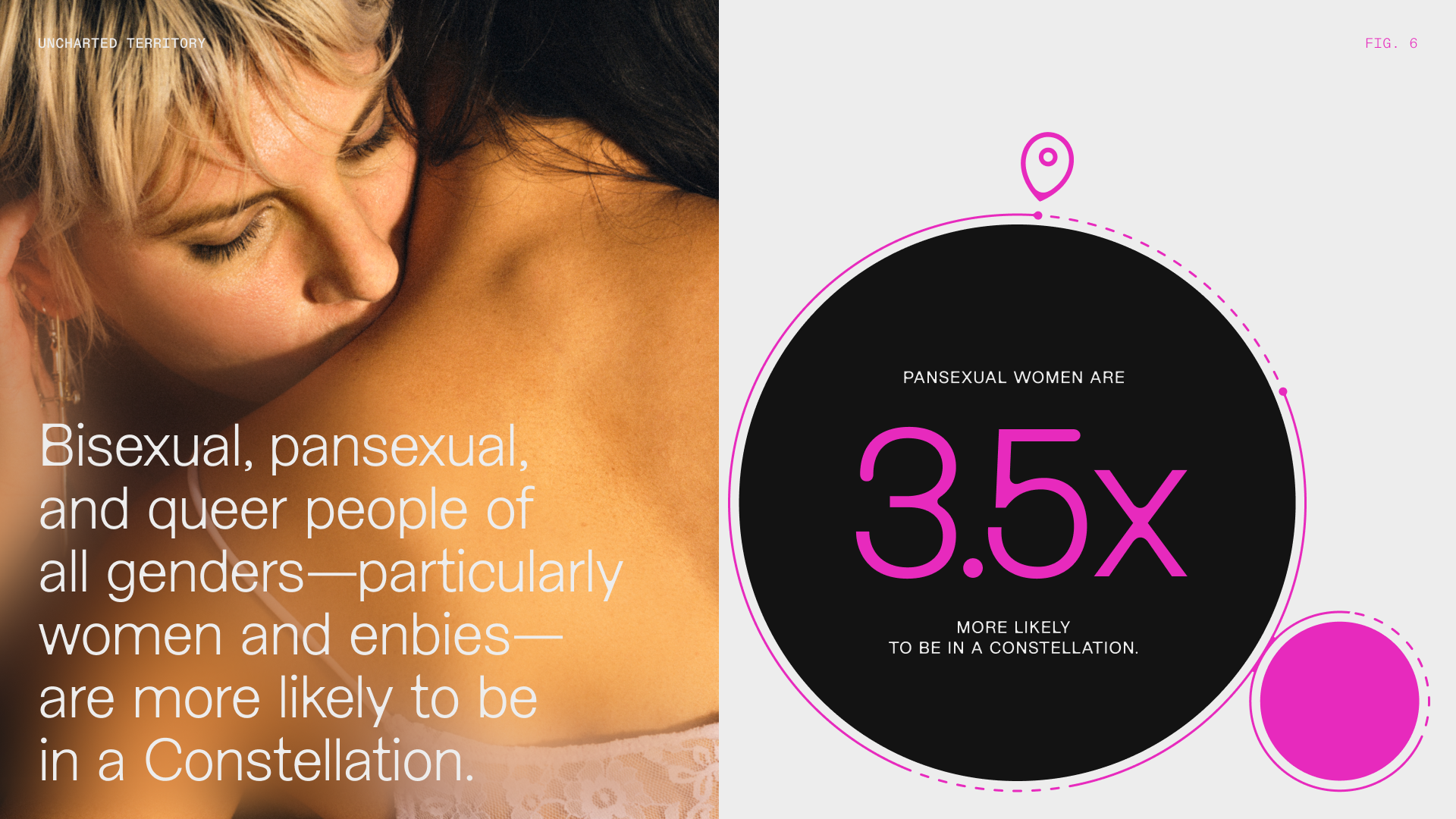
And what of the “Kevin Bacon theory”? How many degrees of separation are Members of a Feeld Constellation removed from one another? Of course, this depends on the size of the Constellation, with larger Constellations having more degrees of separation between Members. An interesting rule of thumb emerged from this analysis: the number of degrees of separation in a Feeld Constellation is roughly half the number of Members in the Constellation. So a 4-Member Constellation has roughly 2 degrees of separation between Members, a 6-Member Constellation has 3, and so on.
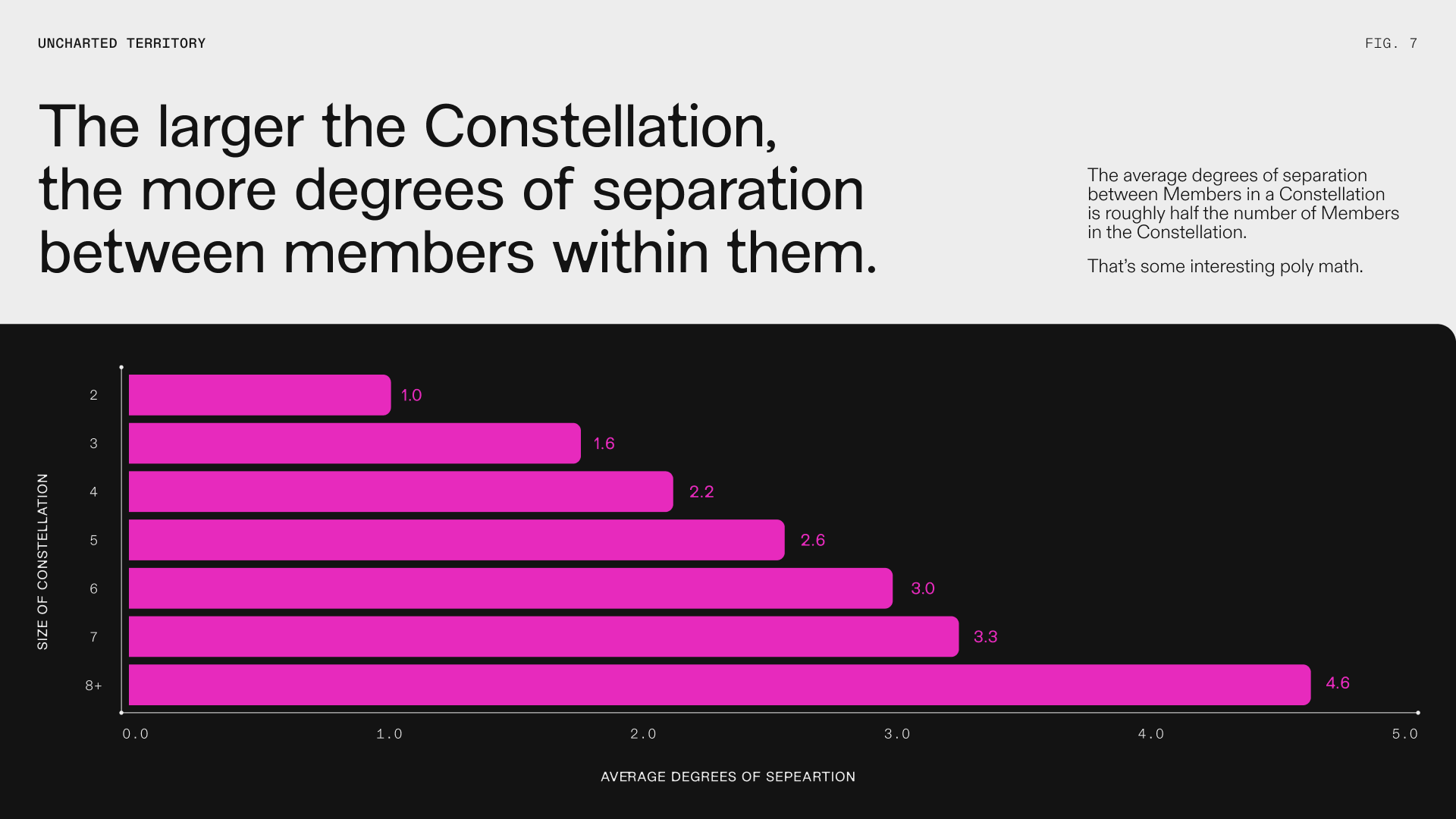
However, degrees of separation between Members in a Constellation also heavily depend on how “ring-like” or “chain-like” the Constellation is. A ring-like Constellation with the exact same number of Members as a chain-like Constellation has fewer degrees of separation between Members; it’s a tighter, more-connected network. This is because hub Members who are highly-connected bring disparate arms of the overall Constellation closer together. In fact, the maximum degrees of separation in a Constellation is directly proportional to the most-connected hub Member in the Constellation. More-connected hub Members can reduce the average degrees of separation for all Members in a network by up to 3x, making for a much more connected network.
“But what are we?”
A big part of the Constellation-forming process on Feeld is assigning a wide variety of labels to the relationship. Members can choose from a variety of 18 possible options from “partner” to “friend,” “dom” or ”domme” to “sub,” “engaged” to “friend with benefits,” and “lover” to “queerplatonic partner.” Blank is also an option! Furthermore, Members can define each relationship independently of each other, so two individual Members linking themselves in a Constellation may label the same relationship in 2 different ways.
Labels are symmetric in nearly 90% of cases, and where they differ tends to be due to the complicated verbiage surrounding ethical non-monogamy. The most common disparity is one Member labeling the relationship as “dating” while the other uses the “partner” label. There are similar disparities between “lover,” “friend with benefits,” and “play partner” as well as “partner,” “nesting partner,” “primary partner,” and “secondary partner,” predictably.
Our Members’ relationship choices shed new, quantitative light on some key aspects of the polyamorous and ENM communities. Feeld Members overwhelmingly prefer non-hierarchical relationship labels: “partner” is nearly 10x more popular than the “primary partner” and “secondary partner” labels. In fact, the generic “partner” label is the favorite by far, describing more than 1 in 3 relationships on Feeld. The second most common label is “married” with 13% of the total, which is a beautiful expression of the “ethical” part of “ethical non-monogamy.” “Dating” is the next most common label choice at 8%. Surprisingly, “nesting partner” is the fourth most popular label, also at 8%, more popular even than “friends with benefits,” “lover,” “dom(me)/sub,” and “friend.” The popularity of “nesting partner” and “married” in particular showcases the types of mature, committed relationships that form the basis for larger Constellations.
And what of platonic relationships? Nearly 6% of all relationships use the “friend” label, 4% use the “metamour” label, and 3% use the “queerplatonic partner” label. Despite platonic relationships being a minority on Feeld—making up 1 in 8 total relationships—these Constellation Members have 50% more links to other profiles on average, producing larger Constellations. These Members are also much more likely to be queer, bisexual, demisexual, and asexual than overall Constellation Members. Platonic Constellations are part of the beautiful diversity of the Feeld community and allow our Members to connect in wholesome, creative ways. Even Shygirl is a fan of friendship Constellations!
Ain’t no mountain high enough
Like stars within the same constellation in the night sky that are thousands of light years apart, Feeld Constellations can span thousands of miles here on Earth. Our Members’ relationships transcend geographical boundaries. Some U.S.-based Constellations span the West and East coasts, connecting multiple states and multiple metropolitan areas within each state. In many cases, a single hub Member is enough to bridge the distance between smaller relationship groups in disparate geographies. The median Constellation spans 2 unique cities and over a quarter span 3+ cities. The most spread-out Constellation on Feeld spans 5 countries!
Some cities repeatedly came up when analyzing Constellations with 3+ Members. Seattle and Portland are the #2 and #4 most popular cities for Constellations. Interestingly, there are more Constellation Members in Seattle and Portland than either Los Angeles or London, despite the latter cities being much larger. And Seattle and Portland have double the share of Feeld Members in Constellations than Los Angeles and London as well as other major cities such as New York City, Berlin, and Paris. Apparently there’s some truth to the adage that Seattle really is just one big polycule.
Star maps of Feeld
Take a look at some real Feeld Constellations, anonymized of course.
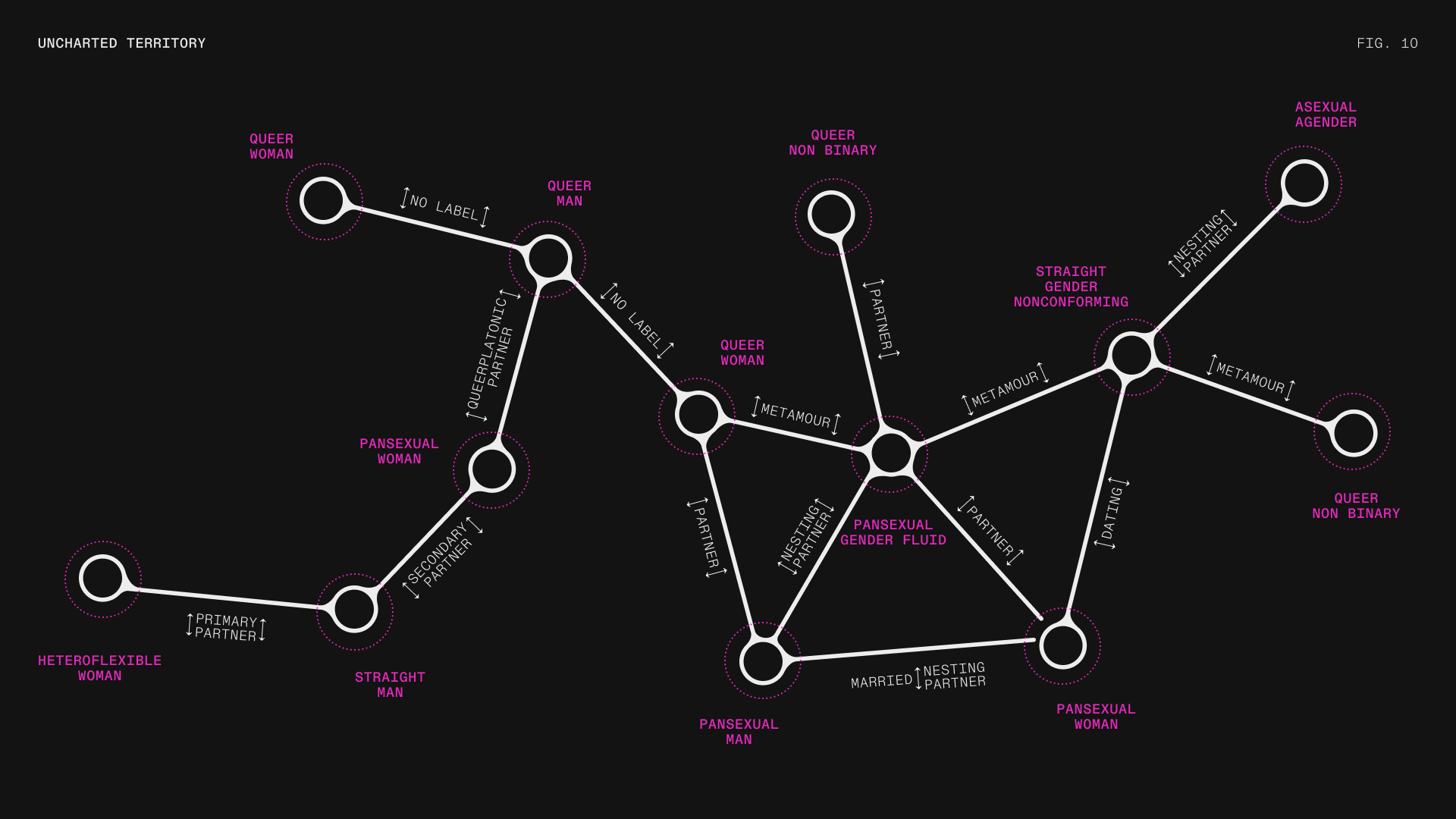
This 13-person Constellation is an excellent example of the diversity of identities and relationship types that makes Feeld special. Note that there are some denser parts where a Member is in relationship with many other Members as well as some chain-like parts of the network where a Member may only be in relationship with one other Member. Also note the case where partners placed different labels on the same relationship (Married and Nesting partner).
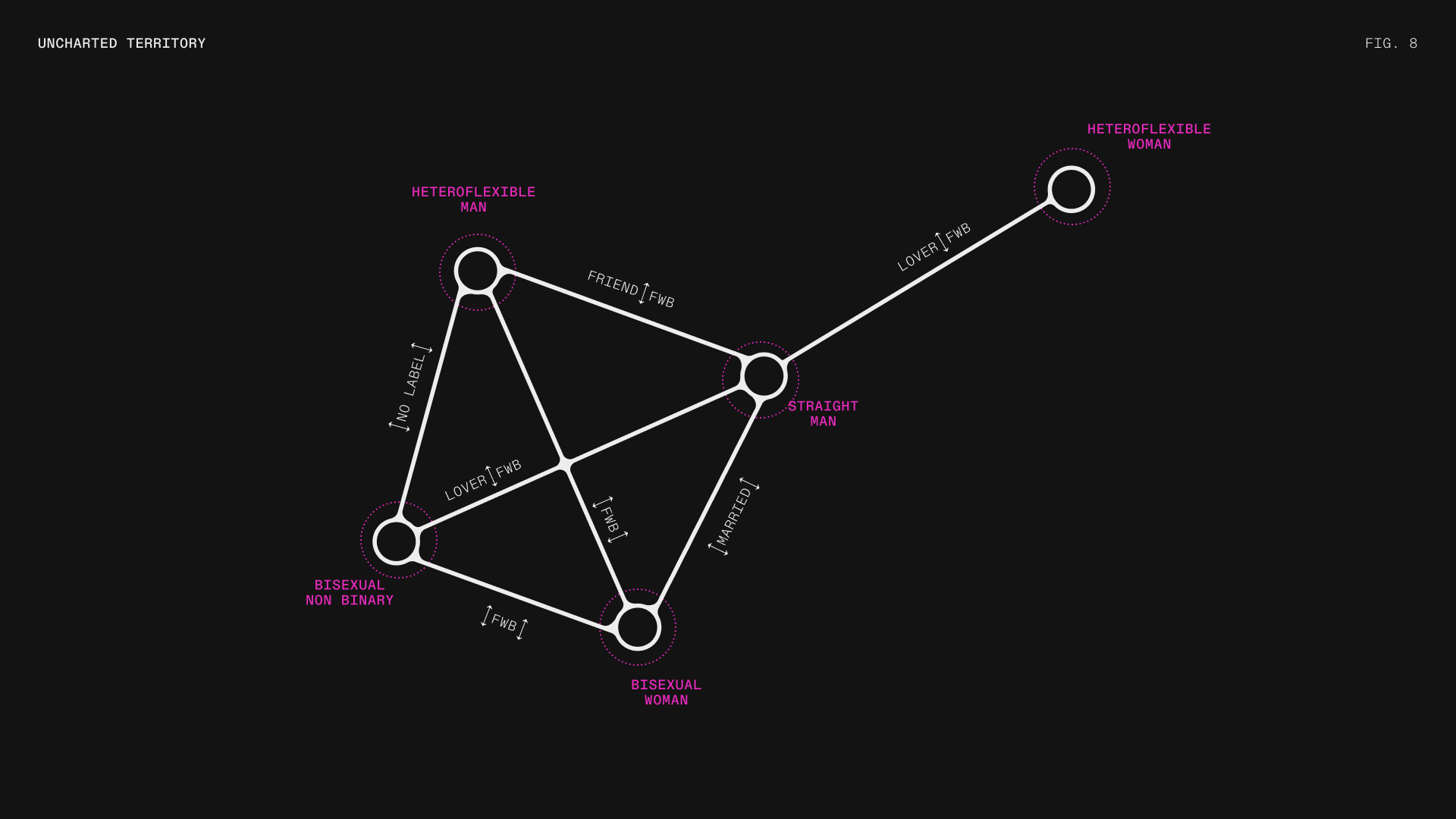
In this Constellation there is a fair amount of mismatch in relationship labels. The common denominator appears to be a straight man in the center of it all who disagreed on labels with 3 out of his 4 Constellation links. Notably, there is a clear misalignment between him and a heteroflexible man who labeled the straight man a friend with benefits despite him considering the heteroflexible man a friend. This specific discrepancy highlights how gender and sexuality labels inform and circumscribe relationship labels.
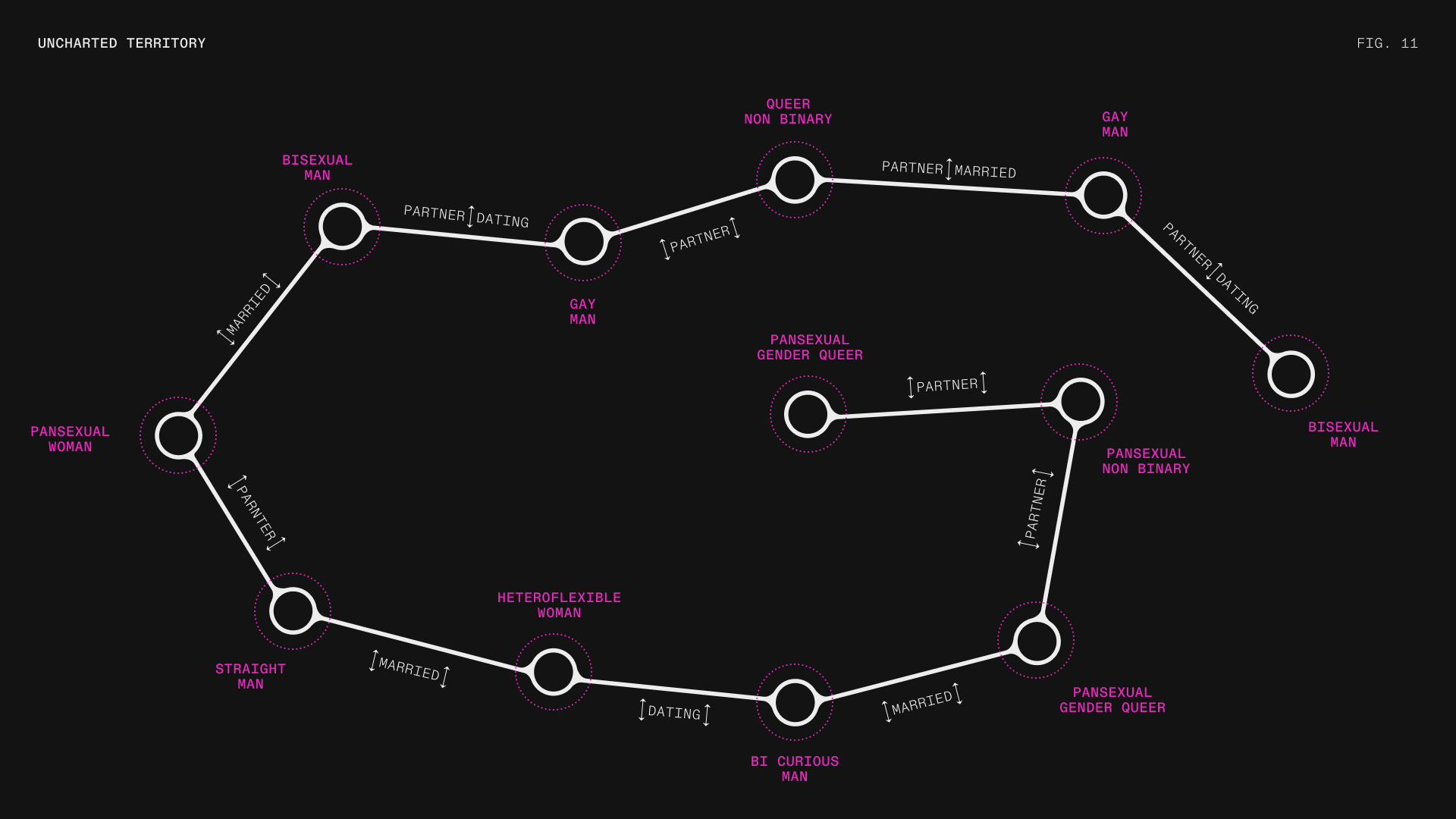
This Constellation is an example of a long chain where each Member is in relationship with a maximum of 2 other Members. Notably, there are at least 4 marriages represented here, each removed from another by a single Member.
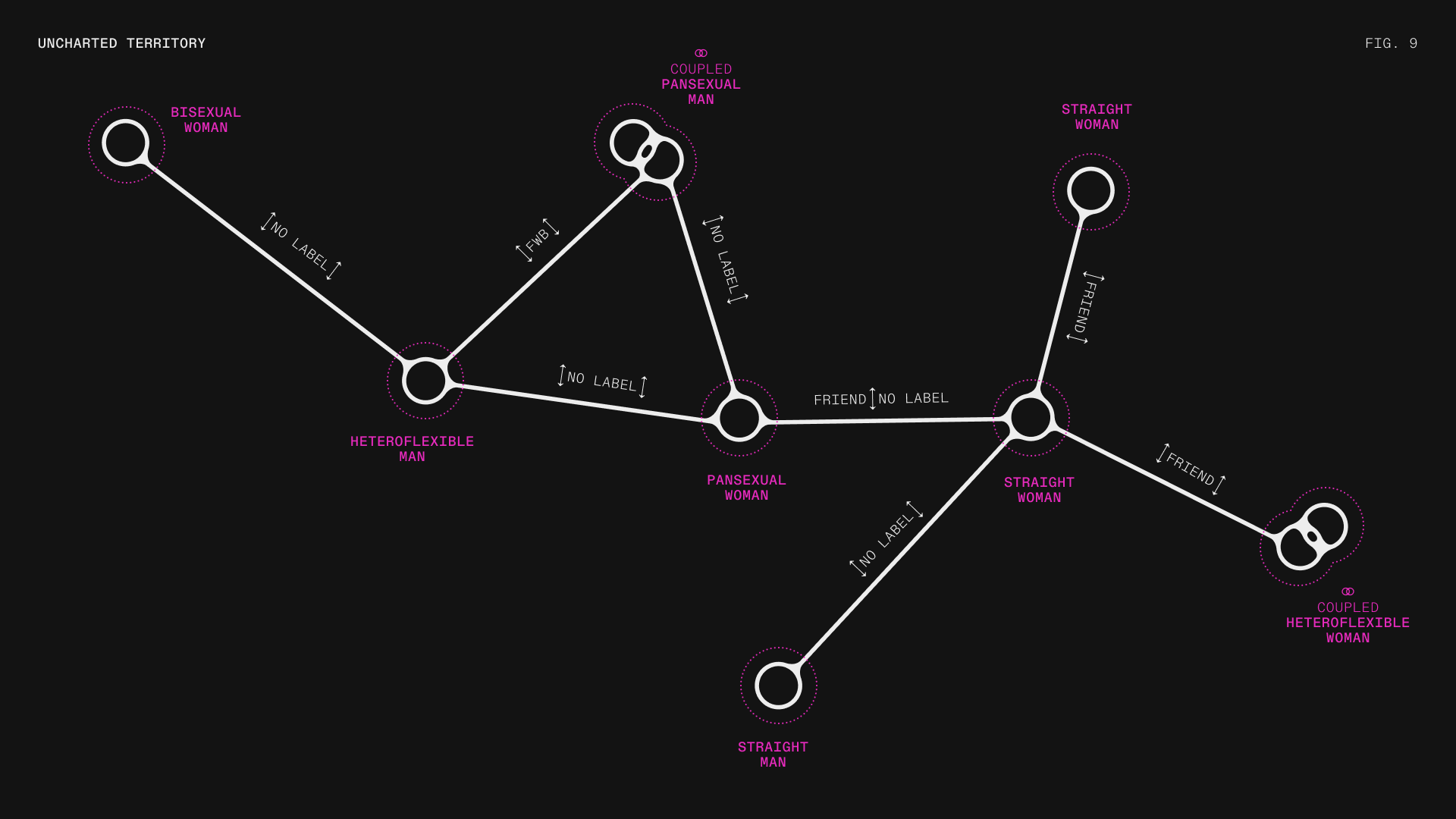
This Constellation demonstrates several interesting phenomena. First, the general refusal of labels. Second, single profiles being used to represent a couple. One wonders what the relationships between these people are, and who the relationships are actually between considering that multiple people are being represented by a single profile.
Cosmic beauty
We humans have always been relational beings, so it’s no surprise that the shapes and forms of our relationship structures are ever-evolving, overlapping, and fluid. This is no more evident than when we take a macroscopic view of Feeld’s Constellations. This one-of-a-kind vantage point allows us to see—with crystal clarity—the nuances of what it means for many people with many different identities, desires, locations, and goals to come together. They are as complex as they are authentic, label-defying while still striving towards a language that best represents them. What a beautiful reminder of how connected we are, even if you can’t see it from where you sit.


